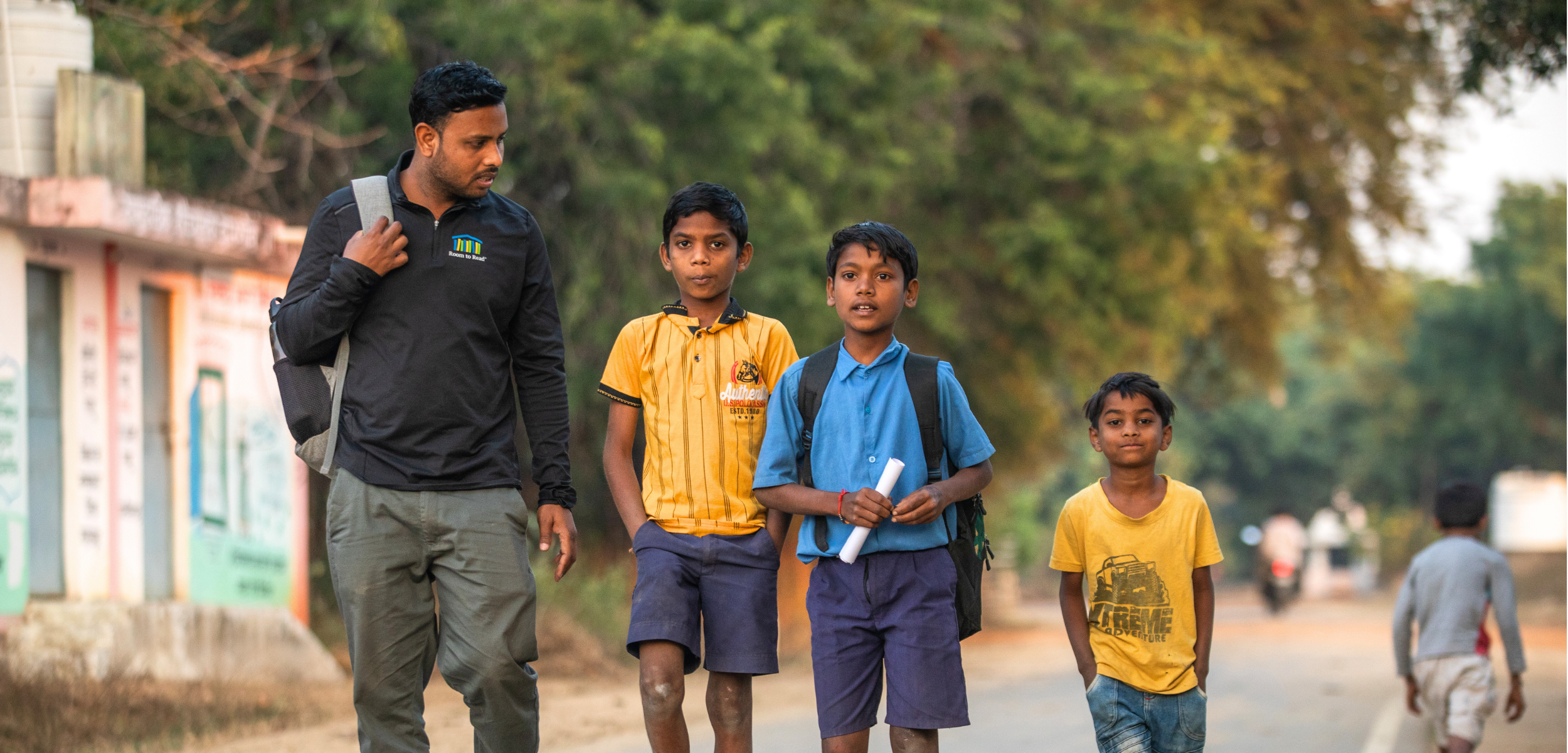
By Dhiraj Anand
Associate Director, Research, Monitoring and Evaluation
Room to Read's Gender Equality Portfolio
Recently, I was involved in piloting our Adolescent Life Skills Assessment (ALSA) tool specifically for adolescent boys in India and Nepal (or ALSA-M as we refer to it). Conducted in semi-urban areas of Chhattisgarh and Telangana in India, and the Nuwakot district of Nepal, the pilot involved quantitative and qualitative work with boys from multiple grades, including cognitive interviews and focus group discussions. Despite clear socio-cultural and linguistic diversity across these locations, it was fascinating to notice some remarkable similarities in the boys' normative thought patterns.
This work builds on our ongoing use of the Adolescent Life Skills Assessment for Girls, a tool we developed to support our research and evaluation work. Through ALSA, we examine whether girls participating in Room to Read’s Girls’ Education Program are developing key life skills more rapidly than their peers in comparison schools. In this post, I want to share two trends from the boys’ pilot that deeply interested me.
Difficulty expressing emotions
One clear observation that emerged from our qualitative work was that adolescent boys struggled significantly with openly expressing emotions sometimes viewed by society as "negative," such as sadness, shame, frustration, jealousy, anxiety and fear. Throughout our interactions, boys consistently mentioned their hesitations, primarily due to fear of judgment or ridicule from peers. Their reluctance reflected deep-rooted societal expectations about how a man, or a strong male should behave.
During the focus group discussions, most of the boys believed they would never share their sorrow or jealousy with others, as it will make them appear "less of a man" and expose them to ridicule. They made it clear that a boy’s role is associated with not discussing these emotions either for oneself or peers. The following excerpts from a focus group discussion illustrates this point further:
- Question: What kind of feelings are you comfortable sharing with others?
- Answer: We can only share happiness, joy or if there is a fight — but this to only to friends so that we can fight back in a group.
In another focus group discussion, boys talked about their hesitation to discuss depression:
- Question: Why?
- Answer: Because one doesn’t know if the [the other person] is depressed.
- Question: Can you tell if someone is depressed?
- Answer: Yes, we can have a look at him and tell. He will eat alone, sit alone, cry when alone. He will not talk to anyone. He will be irritated and very short tempered.
- Question: So, when you see someone acting this way, how do you approach the person?
- Answer: We do not. Unless it is a very close friend.
- Question: Why might someone feel depressed?
- Answer: Love, money problems or if someone has lost money in online gaming, etc.
Parental relationships further complicated matters. Boys frequently mentioned that confiding emotional struggles to parents was challenging due to anticipated disappointment or severe reprimand. For example, if their worries were connected to mistakes that parents would deem as unacceptable, they would prefer not to share how they feel out of fear of punishment.
As a boy from Nuwakot explained during a cognitive interview: "I can't tell my parents if it's my fault if I have lost money or have lent to my friends. They might beat me first, then ask questions."
Increasing engagement with social media and online gaming
The second prominent trend was the rapidly growing influence of social media and online gaming in the lives of boys. Internet access has dramatically expanded across India and Nepal, driven by affordable data plans. Recent reports indicate a significant surge in internet use in rural India, with more than 425 million users; 44% more than in urban areas, where adolescents are becoming major users[i]. Similarly, in Nepal, internet use reached 73.32% by early 2025, with a notable increase among young people[ii].

Our interactions indicated substantial digital engagement among these adolescents. Studies from India report that 60% of adolescent boys (aged 9-17) spend more than three hours daily on social media or gaming platforms[iii]; this seemed consistent with my experience talking to boys about this topic. Boys from Nepal also indicated spending at least 3 to 5 hours daily on social media. Alarmingly, during focus group discussions and cognitive interviews, many boys revealed spending entire nights playing games like Free Fire and PUBG, often unnoticed by parents.
The consequences of extensive online engagement were covered in our conversations. Participants in Nepal shared distressing experiences, such as significant financial losses due to gaming addiction and instances where severe stress led peers to attempt suicide. These accounts align closely with various reports[iv], which reported a rise in gaming-related distress calls along with the cybercrimes.
Additionally, boys shared concerns about online harassment, cyberbullying, and blackmail. One participant stated: "I had a friend whose account was hacked, and he lost around 50,000 NPR when he was playing Free Fire game. He couldn’t tell anyone. Eventually, he tried to commit suicide."
Upon asking if girls also play online games, boys responded in affirmative that girls do play online games but mostly spend time on Instagram and TikTok making videos, often wearing mini dresses and makeup to become viral. When asked if boys also use makeup to get their videos viral, they chuckled and remarked, "men do not do makeup."
Another critical issue to consider is that many of these boys are first-generation learners whose parents often lack the necessary digital awareness and resources to protect and guide them effectively online. Moreover, societal expectations around masculinity discourage boys from openly discussing emotional struggles, increasing their isolation and vulnerability.
Implications for measurement
Given these insights, it is crucial to carefully consider how our assessments measure life skills like emotional resilience, and gender knowledge and attitudes among adolescent boys.
At Room to Read, we use innovative techniques to ensure the cultural and contextual relevance of our programming. When it comes to measuring life skills for boys, items must resonate with their daily experiences and language, including their digital realities and notions around sharing "negative" emotions. In our ALS-M tool pilot, we included items and scenario-based questions related to popular culture and social media, which were positively received by most boys. Many mentioned that these scenario-based questions prompted deep thinking and felt highly relevant to their daily lives. The pilot process gave us a much-needed validation that we are in the right direction of capturing life skills and gender-related knowledge and attitudes that align with the boys' real-world experiences and digital interactions.
Moving forward, the importance of focusing on nuanced rather than obvious gender differences must be emphasized. We will closely examine the interconnections between how boys perceive their own gender roles, especially regarding emotional sharing, and how girls perceive gender roles and attitudes, both offline and online. This should provide a richer understanding of gender dynamics and differences in both physical and digital worlds.

References
[i] https://economictimes.indiatimes.com/tech/technology/rural-india-pips-urban-india-in-internet-usage-with-44-more-users-report/articleshow/98704031.cms?utm_source=chatgpt.com&from=mdr
[iii] https://www.indiatoday.in/technology/news/story/more-than-half-of-indian-youth-aged-9-17-spend-over-3-hours-daily-on-social-media-gaming-study-2449702-2023-10-16








